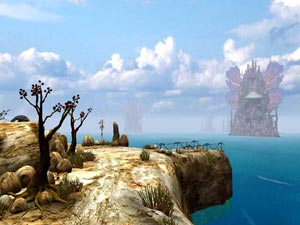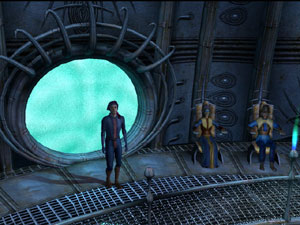Mysterious Journey II, by Detalion, is the sequel to Schizm: Mysterious Journey. Schizm was less than spectacular, with a weak and confusing plot, terrible under-clued puzzles, and a few serious interface and design problems. Mysterious Journey II is much better than its predecessor on the whole, but it has its own quirks and is definitely, uh, unique among adventure games.
Unlike Schizm, MJ2 has a coherent and comprehensible plot. It's not necessarily imaginative, exhausting the list of clichés for the genre: The hero Sen wakes up with amnesia and is forced to explore some nearly entirely abandoned places torn apart by polarized sects still fighting an age-old battle; one group clinging entirely to technology, the other trusting only in magic—I mean nature—well, it's both. To be fair, there are a few unexpected plot twists along the way, but the final deus ex machina ending was far too contrived to be satisfying.
It is set on the same world as Schizm, but only the sight of some familiar floating sea castles confirms that. I'm still not entirely sure whether MJ2 is set before or after the adventure in Schizm. So, it's not necessary to play Schizm first, and it won't help one bit, either.

MJ2 has several non-player characters. The game deals with them and the complexities of convincing interactive conversation in the simplest and most common way: it only lets NPCs appear in cutscenes. After that, Sen is sent off to go explore somewhere alone again. That's probably a good thing, because the voice acting is of low quality. Sen himself sounds believable enough, but a few other characters read from their scripts in monotone.
That leaves the really different part about MJ2: the puzzles. There wasn't much variety to them, since at least half were of the sort where you first figure out what all the controls on some contraption do and then deduce how to use them to reach the solution state. It seemed a bit strange to encounter such things even in the world of the naturalist-magicians. One puzzle I just have to mention is a maze in which you have to draw out your path on paper, then walk it without being able to see it any more. If you misstep, you fall and have to start over. It screams for a nomination for Most Annoying IF Puzzle (Maze division), but at least the desginers provided several visual and audio cues by which you can orient yourself, and you can save the game partway through the maze. Luckily, that maze was the worst puzzle by far. Most puzzles are at least fair, and I only had the feeling that something was slightly under-clued a few times.

What surprised me about MJ2's puzzles is how much math they involve. I'm a mathematician, so I enjoyed figuring out some of the more complicated interacting gizmos. But if you're not comfortable doing arithmetic in non-decimal bases or converting between different bases or solving a set of three simultaneous equations mod 16 with three unknowns, some of the puzzles might be frustrating. It's not uncommon to find nice math hiding underneath good puzzles, but usually IF games don't require working math problems out on paper. I like to think I could explain Riven's numbering system without explaining generalized digits and bases, but it would be difficult to explain my solutions to some of MJ2's puzzles to a non-mathematician.
The game play as a whole was extremely segmented and linear. Hardly any of the puzzles integrate convincingly into the world. Most are supposed to be security systems of some sort, but either could be figured out by anyone with enough time on their hands (as the player proves) or the code is constructed from knowledge everyone who lives in that world would know. I only recall one, maybe two times when two puzzles were available simultaneously. Linearity is blatantly enforced by doors and portals that shut behind you and objects that aren't active until it's time to solve that puzzle. (Even so, I managed to wander off somewhere I wasn't supposed to once, and got the game into an unwinnable state.) It's always fairly obvious what to do next, but at the price of heavy-handed control over the player. Essentially, the game reduces to one brainbusting puzzle after the next.

I'm afraid I have some gripes about the technical appearance and feel of the game. Like realMyst, it's a first-person game that allows you to move continuously through a scene as well as pan the view left, right, up, and down. That's a very difficult task for all but the very best modern video cards. I actually played on a computer without a "transform-and-lighting" video card, which is technically required. MJ2 was still playable, but the Settings screen in the menu always crashed the program, the cutscenes were terribly slow and out of sync, walls would occasionally flicker in and out of view, and in some locations trying to move around became much slower. At the worst, an elevator got stuck mid-shaft (but I was able to keep it inching upward by repeatedly pressing the space bar). I can't guarantee anybody else trying the game without minimum specs will be as lucky, so if you buy this game, make sure you have either a video card with T&L or a vendor who's willing to accept a returned open box.
That much freedom in movement isn't really necessary in a graphical IF game anyway, although producers seem to think that the more money spent on the engine, the better the game will sell. Continuous motion always seems to cause interface problems, but as long as the views from adjacent locations overlap enough, it will feel like a real world. In MJ2 I had to stand ridiculously close to most objects to click on them, a problem that doesn't come up with the simpler game engines.

Speaking of hotspots, I really have to commend the designers for adding a radar-like indicator that lets you know when a hotspot is nearby and in which direction. It might be unrealistic, but there's nothing worse in playing graphical IF than searching painfully for the exact spot to click or failing to realize that something is interactive. The radar did give a few false alarms on hotspots far above or below me, and at one point I got frustrated for about a minute searching for a hotspot that was on the radar but not yet clickable.
The save game interface entirely ignores the possibility of more than one person playing the game on the same computer. You can name your games anything you want in order to distinguish them, but only when you manually save—it also automatically saves whenever you accomplish something important, and since you can't overwrite or delete saved games, you'd easily get your list buried in a pile of autosaves. Even as a different user on Windows XP, the saved games are the same; I had to delete a subdirectory of games from a previous player and change some folder permissions before I could really start playing.
My conclusion: If you like challenging mathematical and logical puzzles for their own sake, this game could be worth a try. If not, you should probably give it a pass. I'd recommend Mysterious Journey II to certain people I know enjoy that sort of thing, but not to everybody, and not as a favorite or must-play.
This article copyright © 2005, Andrew Schepler
